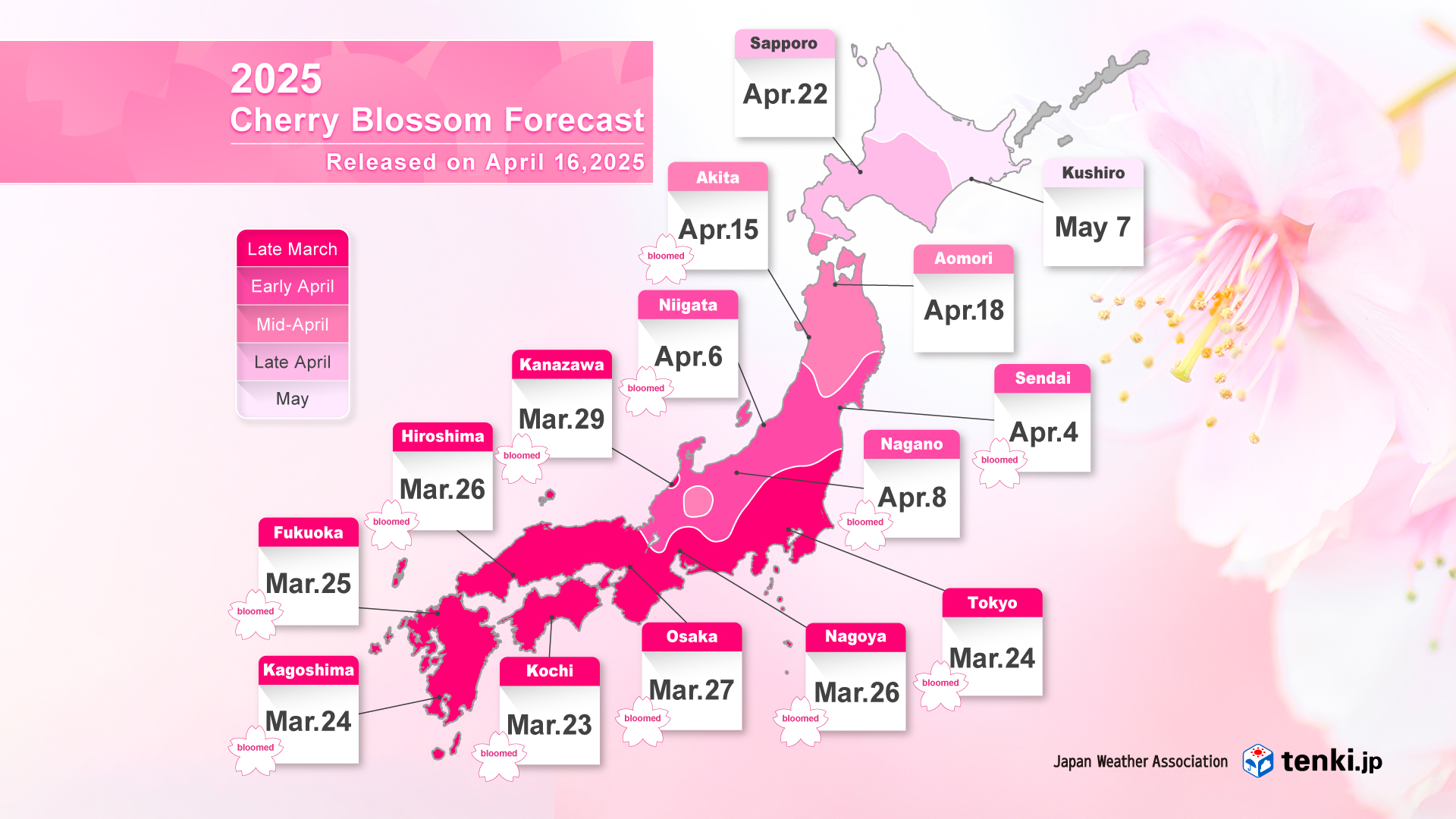News
2025 Cherry Blossom Forecast (as of April 16th)
2025.02.21
In Japan, sakura (the Japanese word for cherry blossom) bloom in spring, from around March to May.
Japanese people visit famous spots to view the cherry blossoms and enjoy the scenery, which is a Japanese tradition known as ‘hanami*’.
* Hamani, created from the words “flower” and “see.”
Although it varies by region and climate, cherry blossoms generally take 10 days to two weeks from the start of blooming to full bloom and for the petals to begin falling. After reaching full bloom, the flowers typically shed within a week. Therefore, the period to enjoy cherry blossoms in full bloom is short and limited.
Japan Weather Association (JWA) publishes forecasts of blooming and full bloom dates for cherry blossoms across Japan’s various regions to ensure that people do not miss the short cherry blossom season.
JWA released its part 7 forecast for cherry blossoms and full bloom across 84 locations throughout Japan on Wednesday, April 16th, 2025.
PLEASE REFRAIN FROM USING THIS INFORMATION FOR CORPORATE PURPOSES (SUCH AS QUOTATIONS IN PRESS RELEASES, USE FOR PROMOTIONAL PURPOSES, AND POSTING ON COMPANY MEDIA OR SIGNAGES) WITHOUT PREMISSION.
For corporate use, including information provision to users or product PR, please contact us using the inquiry form provided in the link below.
Key points for the 2025 cherry blossom forecast (as of April 16th)
- Areas such as Hokuriku, Nagano, southern Tohoku and adjacent areas are now in Full Bloom.
- Northern Tohoku and Hokkaido are expected to bloom earlier than average overall.
- Full bloom is expected to occur in northern Tohoku towards the end of April, and in Hokkaido from late April to mid-May.
2025 Cherry Blossom Blossoming Trend
As the cherry blossom front moves northwards, currently through the Tohoku region, many areas in northern Tohoku and Hokkaido are expected to bloom earlier than average, with some parts of Hokkaido expected to bloom significantly earlier this year.
Northern Japan experienced temperatures higher than average from March and beginning of April, and the warm weather is expected to continue throughout April.
Because of these high temperatures, cherry blossoms are expected to pop up one after another across northern Tohoku by the end of this week. In Hokkaido, blossoms are expected to bloom 5 to 9 days earlier than average, between mid-April and early May.

* The cherry tree’s Blooming date is defined as the first day when five to six or more flowers open on a specimen tree.
This is the last cherry blossom forecast of 2025.
For the most recent updates and information on the 2025 cherry blossom please visit the 【tenki.jp】 The Cherry Blossom and Full Bloom Forecast page (Only available in Japanese).
2025 Cherry Blossom Full Bloom Trend
Higher altitude areas in Gifu and northern Tohoku are expected to reach Full Bloom around or earlier than the seasonal average, meanwhile many areas in Hokkaido are forecasted to reach full bloom significantly earlier than usual.
The peak viewing season has already passed in many areas from Kyushu to southern Kanto.
Currently, regions such as Hokuriku, Nagano and southern Tohoku are experiencing optimal cherry blossom viewings. Looking ahead, northern Tohoku is expected to reach Full Bloom towards the end of April.
In Hokkaido, cities like Hakodate, Sapporo and Obihiro are expected to be in Full Bloom by the end of April, while other locations are expected to reach Full Bloom from early to mid-May.
[Description of words]
| Normal | Average of 1991-2020 |
| Much earlier | 7 or more days earlier than normal |
| Earlier | 3 to 6 days earlier than normal |
| Near normal | 1 or 2 days earlier or later than normal |
| Later | 3 to 6 days later than normal |
| Much later | 7 or more days later than normal |
On JWA’s weather forecasting media ‘tenki.jp’, the average dates for cherry blossom blooming and full bloom, as well as the criteria for blooming and full bloom, are explained.
Click here to read: 【tenki.jp】Cherry Blossom Season in Japan
About JWA’s Cherry Blossom Forecast
Cherry Blossoms and Viewing Party
Somei-yoshino is a species of cherry tree that is planted throughout Japan and is one of the most commonly seen trees in the country.
Blooming begins in late March at the lower altitudes of Kyushu and Shikoku, and gradually moves to Honshu, Hokkaido and higher altitudes through to April.
When cherry blossoms are in bloom, many people have a party under the trees called ‘hanami’ and enjoy food and looking at the scenery to celebrate the arrival of spring.
How They Bloom
When the flowers bloom largely depends on the temperatures from the fall in the previous year to spring.
Cherry blossom buds are formed in summer and then become dormant. When they are exposed to low temperatures for a certain period of time in winter, the buds awake from dormancy.
This is called ‘dormancy breaking.’
The awakened buds grow and unfold as the temperature rises.
It is considered that the higher the temperature, the faster the growth of the buds and the earlier they bloom.
Data Used for Forecasting
JWA refers to the trends in the temperature since autumn of the previous year, which has a significant influence on the growth of buds, and uses its own formula for forecasting as well as the following data:
- Observed temperatures from the fall of the previous year to the day before the forecast is made
- Expected temperatures from the day when the forecast is made to the flowering period (JWA’s pinpoint forecast and long-term forecast)
Business Utilization of Cherry Blossom Forecasts
The cherry blossom season is one of the peak periods of international travelers visiting Japan.
JWA’s accurate cherry blossom blooming and full bloom forecasts contribute to businesses in various industries, such as tourism, accommodation, transportation, media, and event planning.
If you are interested in JWA’s forecasts, please feel free to contact us.